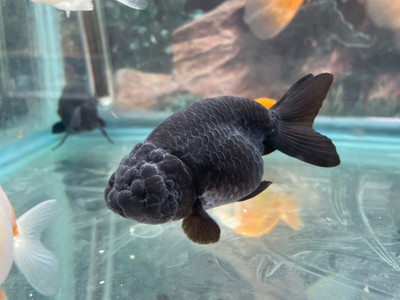Black Ranchu Goldfish
Posted by Max Gandara on on 6th Aug 2025
Black Ranchu Goldfish Care Guide
The Black Ranchu is a stunning variety of Ranchu goldfish, prized for its deep black coloration and classic rounded body shape. Known as the “king of goldfish” in Japan, Ranchus are valued for their smooth, hooded heads and elegant swimming style.
Origin
Ranchu goldfish originated in Japan through selective breeding of common goldfish and lionhead varieties. The Black Ranchu is a color morph distinguished by its rich black scales, which can deepen in shade as the fish matures.
Appearance
Black Ranchus have a rounded, egg-shaped body with a broad back and no dorsal fin. Their distinctive head growth (wen) covers the top of the head and cheeks, creating a unique, textured appearance. Their black coloration ranges from charcoal to jet black and may vary in intensity over time.
Behavior
These goldfish are peaceful and slow swimmers, making them ideal for community ponds or goldfish-only tanks. They are social fish and enjoy the company of other Ranchus or similarly sized fancy goldfish.
Tank Setup
* Minimum tank size: 20 gallons for one fish, with an additional 10 gallons per extra fish.
* Provide gentle filtration and aeration, avoiding strong currents.
* Use smooth substrate to protect their delicate fins and wen.
* Decorate with live or silk plants to provide hiding spots without sharp edges.
Water Parameters
* Temperature: 65–75°F
* pH: 6.5–7.5
* Hardness: Soft to moderately hard
Diet
Black Ranchus are omnivores and thrive on a balanced diet of high-quality goldfish pellets or flakes supplemented with fresh vegetables and occasional protein treats such as bloodworms or brine shrimp.
Care Tips
* Keep water clean with regular partial water changes.
* Avoid overcrowding to reduce stress and maintain water quality.
* Monitor for common goldfish health issues such as swim bladder problems or fungal infections.
Conclusion
The Black Ranchu is a beautiful and graceful goldfish variety that adds elegance to any pond or aquarium. With proper care and a peaceful environment, they can live for many years, becoming a rewarding companion for fish enthusiasts.
---

